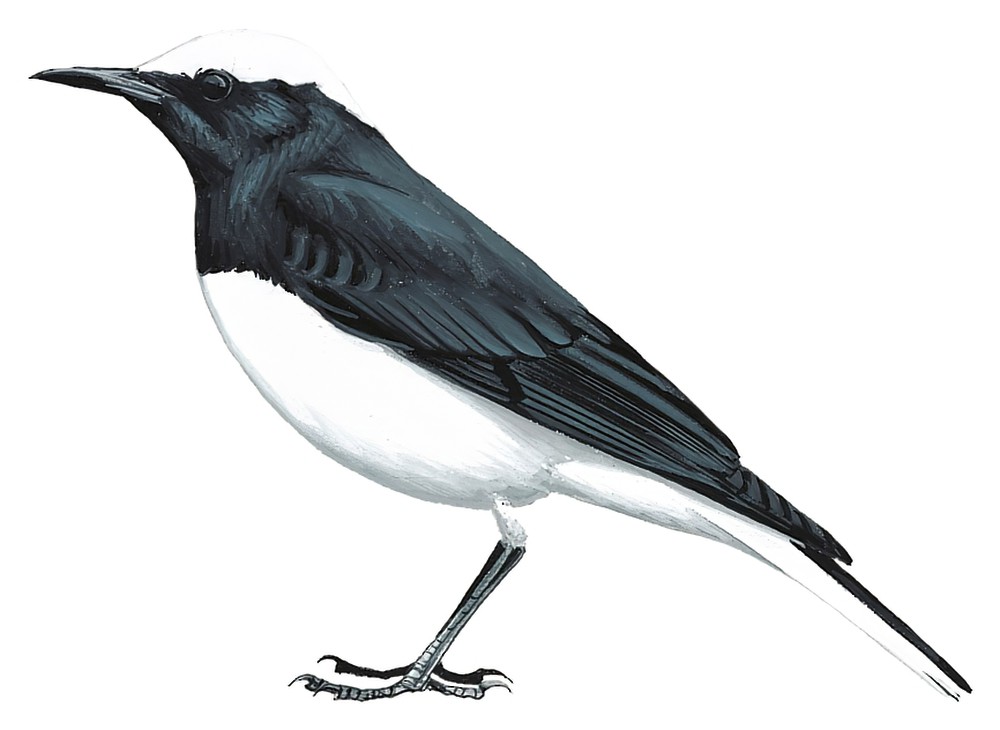Hooded Wheatear / Oenanthe monacha

Hooded Wheatear
SCI Name:
Protonym: Saxicola monacha Pl.Col. livr.60 pl.359 fig.1
Taxonomy: Passeriformes / Muscicapidae / Oenanthe
Taxonomy Code: hoowhe1
Type Locality: Nubia [= Luxor, vide Stresemann, 1954, Abh. Deutschen Akad. Wiss., Math.-Naturwiss., Berlin, 1, p. 174].
Author: Temminck
Publish Year: 1825
IUCN Status: Least Concern
DEFINITIONS
OENANTHE
(Muscicapidae; Ϯ Northern Wheatear O. oenanthe) Specific name Motacilla oenanthe Linnaeus, 1758; "MOTTEUX, Œnanthe. Motacilla, Linn. Silvia et Turdus, Lath. Bec plus haut que large à la base, droit, très-fendu; mandibule supérieure un peu obtuse, courbée et échancrée à la pointe; l'inférieure plus courte, droite, pointue. — Ailes à penne batarde; la deuxième remige la plus longue. Esp. Motteux, Buff. — Turdus leucurus, Lath." (Vieillot 1816); "Oenanthe Vieillot, 1816, Analyse, p. 43. Type, by monotypy, "Motteux" Buffon = Turdus leucurus Gmelin." (Ripley in Peters 1964, X, 121); "OENANTHE Vieillot, 1816 F — "Le Motteux" Buffon; type by tautonymy = Motacilla oenanthe Linnaeus, 1758" (Dickinson & Christidis (eds.) 2014, 610).
Var. Oeanthe, Ananthe, Aenante, Aenanthe.
Synon. Campicola, Cercomela, Leucotoa, Penthodyta, Pentholaea, Philothamna, Saxicola, Sciocincla, Vitiflora.
oenanthe
L. oenanthe wheatear < Gr. οινανθη oinanthē unidentified bird mentioned by Aristotle, from its appearance in the vintage season < οινη oinē vine; ανθος anthos bloom, associated with the wheatear by later authors; "99. MOTACILLA. ... Oenanthe. 17. M. dorso cano, fronte alba, oculorum fascia nigra. Fn. svec. 217. Oenanthe s. Vitiflora. Jonst. av. 123. t. 45. f. 13. Will. orn. 168. t. 41. f. 4. Raj. av. 75. n. 1. Alb. av. I. p. 53. t. 55. β. Motacilla subtus pallida, rectricibus introrsum albis, dorso undulato. Fn. svec. 219. Oenanthes vitifloræ femina. Alb. av. 3. p. 50. t. 54. Habitat in Europæ apricis lapidosis. Sexu & ætate varia: cessante nocturno frigore advenit." (Linnaeus 1758) (Oenanthe).
monacha
Late. L. monacha nun (i.e. hooded) < Gr. μοναχη monakhē nun < μονος monos solitary < μοναχοω monakhoō to make single.
● ex “Moloxita” or “Réligieuse d’Abissinie” of de Buffon 1770-1783, and “Nun Thrush” of Latham 1783 (Oriolus).
MONASA
(Bucconidae; Ϯ Black Nunbird M. atra) Gr. μονας monas, μοναδος monados female hermit, nun < μονος monos solitary < μοναχοω monakhoō to make single; "35. MONASE, Monasa. Cuculus, Gm. Bucco, Lath. Bec garni de soies à la base, plus long que la tête, comprimé par les côtés, entier; mandibules courbées en en base. Esp. Coucou noir de Cayenne, Buff. ... Monasa [μονασης, qui solus vivit]." (Vieillot 1816); "Monasa Vieillot, Analyse, 1816, p. 27. Type, by monotypy, Coucou noir de Cayenne of Buffon = Cuculus ater Boddaert." (Peters 1948, VI, 21).
Var. Monassa, Monasta, Monacha, Monesa, Monaca.
Synon. Barbacou, Barbaculus, Monadon, Monastes, Scotocharis.
MONARCHA
(Monarchidae; Ϯ Black-faced Monarch M. melanopsis) L. monarcha monarch < Gr. μοναρχος monarkhos monarch, sovereign, dictator (see Tyrannus); "Genus. MONARCHA. Rostrum forte, subelongatum, basi latum, subdepressum; culmine carinato, apice arcuato; mandibula superiore emarginata; naribus basalibus, rotundis, setis plumulisque opertis; rictu vibrissis fortibus instructo. Alæ mediocres, subrotundatæ; remige prima brevi, secunda duplo longiore, tertia et quinta æqualibus, quarta quæ est longissima, paulo breviori; cæteris gradatim breviscentibus: tertiæ ad sextam inclusam pogoniis externis paulatim in medio latioribus. Cauda mediocris, æqualis. Pedes mediocres, acrotarsiis scutellatis, paratarsiis integris. The powerful construction of the bill of this group separates it at once from the other species of the Muscicapidæ, with which in the depression and breadth at the base of that member, the strength of the rictal bristles, and the general characters of the wings and legs, it otherwise accords. This strength of bill would incline us to place the bird among the Laniadæ, and in the subfamily of Tyrannina, Swains., of which it might thus be considered to form the Australian representative, did not the other characters of its structure evince a more predominant inclination to the Muscicapidæ than to the Tyranni. The group may, however, be considered to stand intermediately between the two families; and might perhaps be referred with equal propriety to either, according to the characters which each naturalist would select as most predominant, and most convenient to guide him in his subdivisions. The habits of the birds of this group, hitherto unknown, will have much influence in determining its exact station. 1. CARINATA. ... Muscipeta carinata. Swains. Zool. Illust. pl. 147." (Vigors & Horsfield 1827); "Monarcha Vigors and Horsfield, 1827, Trans. Linn. Soc. London, 15, p. 254. Type, by monotypy, Muscipeta carinata Swainson, 1823 = Muscicapa melanopsis Vieillot, 1818." (Mayr in Peters 1986, XI, 500).
Var. Monacha, Monarches (Gr. μοναρχης monarkhēs monarch).
Synon. Bathmisyrma, Monarcharses, Neopomarea.
UPPERCASE: current genus
Uppercase first letter: generic synonym
● and ● See: generic homonyms
lowercase: species and subspecies
●: early names, variants, mispellings
‡: extinct
†: type species
Gr.: ancient Greek
L.: Latin
<: derived from
syn: synonym of
/: separates historical and modern geographic names
ex: based on
TL: type locality
OD: original diagnosis (genus) or original description (species)












